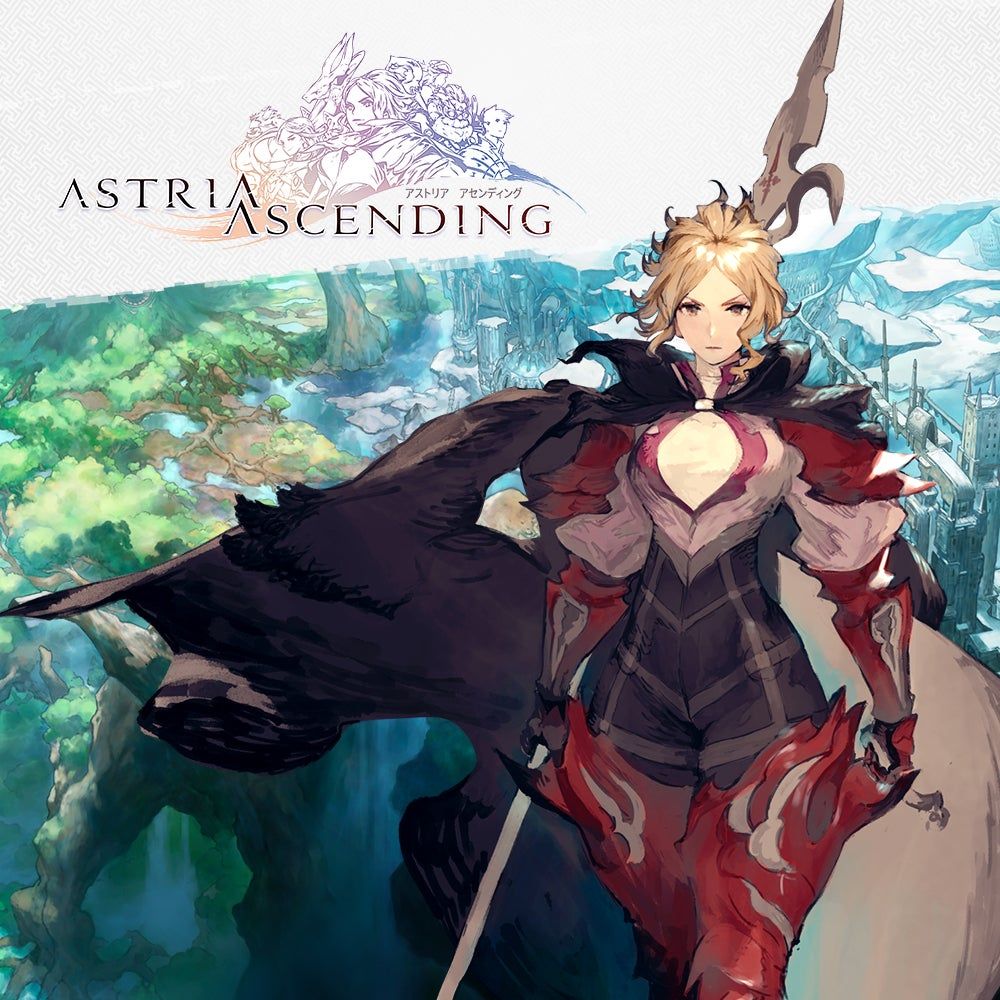Astria Ascending
Developer: Artisan Studios
Publisher: Dear Villagers
Platforms: PC (Reviewed), Nintendo Switch, PlayStation 4, PlayStation 5, Xbox One, Xbox Series X
Release Date: 30 September 2021
Price: 34.99€ – Available Here
Overview
From Artisan Studios, the people responsible for Super Neptunia RPG, comes a new take on traditional J-RPGs. Astria Ascending tries to fill the void left by J-RPGs reminiscent of the old PlayStation One era such as Valkyrie Profile and the old school Final Fantasy games, to mention a few. With the game industry focusing more and more on behemoth projects with inflated budgets that prioritize “realism” and hype to the detriment of passionate and fun focused projects, games such as Astria Ascending are a godsend. With that said, Astria Ascending is an ambitious project for an indie venture; publisher Dear Villagers was able to assemble a veritable team of J-RPG stars. The story and scenario is provided by Kazushige Nojima, who wrote the story for Final Fantasy X. The music is produced and composed by Hitoshi Sakimoto, known for his work on Final Fantasy XII, Vagrant Story and many others. The art is made in collaboration with Cydesignation, known for the art of Nier Automata and Nier Replicant. With a renowned team such as this and the promise of an emotional and mature story, would Astria Ascending be the “second coming” of traditional J-RPGs?
Story
The world of Orcanon is inhabited by five races that diverge enormously in appearance and customs. If there’s something the history of humanity has taught us, it is that any conflicts between races would be resolved by endless bloodshed. Strangely enough in Orcanon, the people is able to coexist peacefully. The five races come together in the city known as Harmonia, which is situated at the center of Orcanon and serves as a symbol of the peace enjoyed by its people. All this peace has a hefty price, though; to be able to live in harmony and be a part of Harmonia’s society, the inhabitants of Orcanon must consume a fruit known as “harmelon”. The harmelon fruit is able to suppress the more extreme emotions of the inhabitants of Orcanon, allowing them to coexist without killing themselves over what belief they might have. It also robs them of much of their individuality and diminishes the innate potential each race might have; the awisi, a race of bird people, isn’t able to fly as high and free as before, for example. Harmonia is overseen by a goddess and her eight demigods. The demigods have representatives from each race, with most of them excelling at whatever proficiency they have. The demigods serve as the “world police”, responsible for maintaining peace in Orcanon and sure enough, they have their hands full, as beings only known as “noises”, threaten to break the harmony.
Astria Ascending’s story is told in a very linear fashion and with very little exposition, especially for the main characters. There will be a disturbance in a race’s dwelling inside Harmonia, and the demigods will rush in to investigate. The story follows this predictable pattern for the first 20 hours, although your mileage may vary. Until you’ve visited all race’s dwellings, their corresponding city outside of Harmonia which they hail from, and a nearby dungeon; the story is drip fed between the main story and each demigod’s own personal issues. This makes it a tad difficult to maintain interest in the story and characters in general.
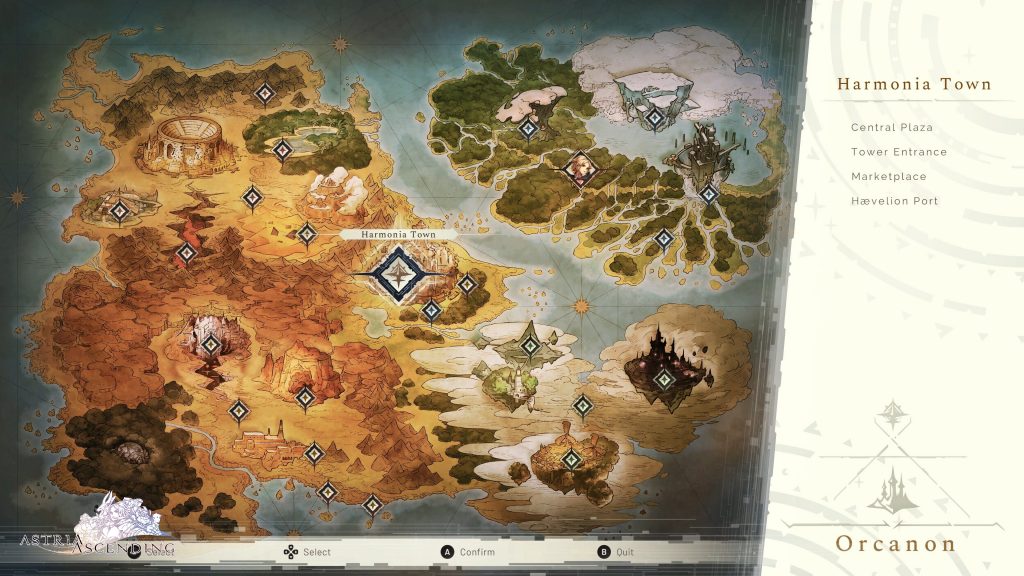
Gameplay
The gameplay is Astria’s Ascending strongest point. It uses what I’ll refer to here as the “Valkyrie Profile formula”, -No I’m not sorry- which means that it combines elements of action, adventure, RPG and platformer games. The game allows players to explore the cities and dungeons in a 2D plane. When in cities, everything stays in the background with only the main character at the front plane. The player is able to interact with objects and NPCs and also enter stores and houses. The way it’s made is a bit cumbersome since you don’t know what can be interacted with; it could be some NPC deep in the background, so you need to pay attention to any prompts that might appear as you walk through the city. Fortunately this same nuance doesn’t apply to dungeons as everything that can be interacted with is very visible and obvious. As you explore dungeons, enemies will appear as a blue, glowing orb. Very early in the game you’ll have the option to either freeze the enemies, so you’ll have a chance to avoid the battle by jumping over them or slash them and try to gain the initiative. The platforming part is very simple. They’re not only ridiculously easy, but if you happen to fall into a pit, no penalty is applied. It also adds a bit of variety to the walk and fight monster pattern. In the first dungeon, you’ll have some puzzles with a basic riddle you need to solve in order to progress. Oddly, these kinds of puzzles basically disappear later on, which is a pity since exploring dungeons mostly boils down to navigating a map and defeating enemies in your way.
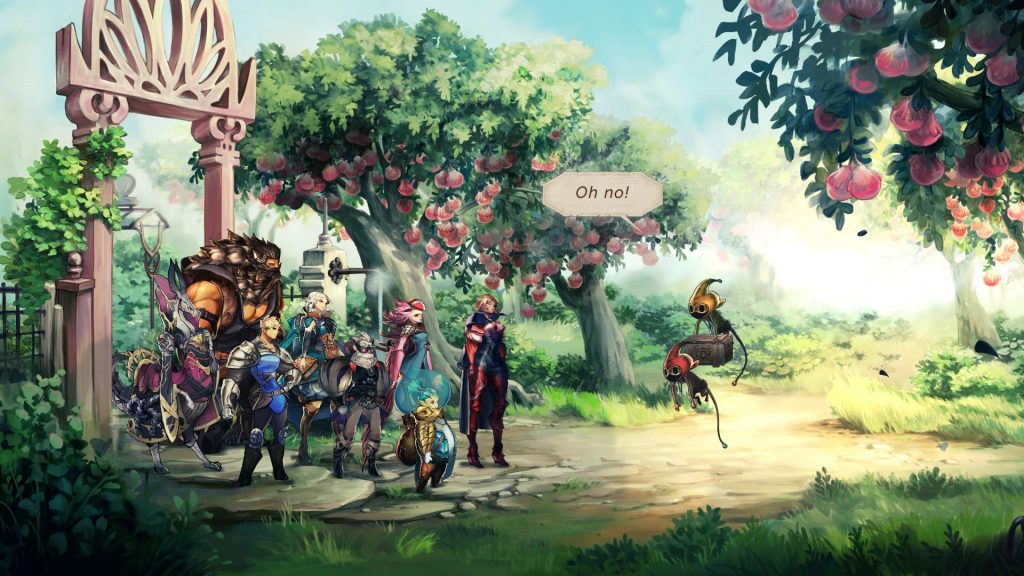
Fortunately, the battle system and everything that revolves around it will keep you entertained enough, if that’s your cup of tea…. At first, every character has a base job which confers upon them certain abilities: Ulan, with her huge shield, is the defender and have abilities suited to protect the other party members; Arpajo is the thief; and so on. Later on, a main job is unlocked on top of the base job and after that a support job. They don’t replace the base job but add to it, each with their own skill tree. This gives a lot of room for character customization. The battle grid is laid out in a traditional turn based RPG fashion. On the right side, four characters out of eight in your party will be used in battle, while the other four will remain dormant, unaffected by any battle outcome. On the left side are your enemies. Every demigod or foe will have a turn each. Their agility stat will decide who gets to act first. A very cool feature of Astria Ascending is the ability to switch party members in battle; With the use of 1 of your turns, you can switch one, two or all four of them in one go. On top of the options you already have regarding the customization of your party, this ability adds one extra layer of complexity to the battle system. It will overwhelm some players for sure, but it isn’t anything overly complicated. The game gives the player a lot of options, but you’re free to just use whatever you think is most comfortable and effective.
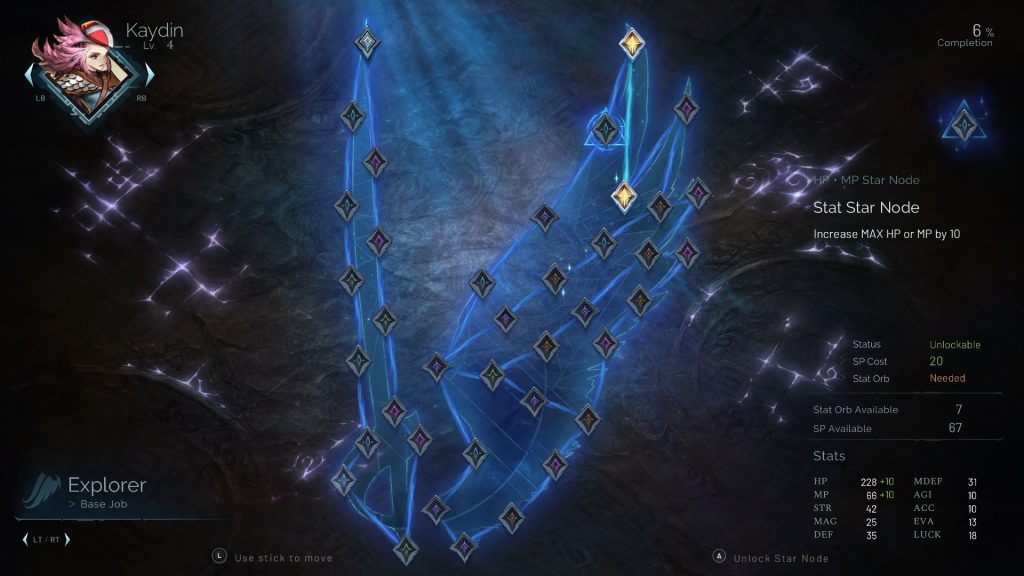
There’s also a neat card game called J-Ster. Early in the game, you’ll receive basic cards and can collect more by defeating opponents or even transforming enemies into cards. It’s frustatingly easy to play against NPCs, but it can provide a fun little distraction from the main quest sometimes.
Visuals
One quick glance at one of Astria’s Ascending screenshots and you’d think this is Vanillaware’s new project, due to the similarity of the artstyle used here. Vanillaware is known for the aesthetic beauty of their titles with games such as Odin Sphere, and, more recently, Aegis Rim. Astria Ascending may not be as polished visually as a Vanillaware title, but it has its own charm. The graphics are a mixed bag, though; it ranges from good loooking to very simple and drab. The main characters are detailed and look very good and attractive, as is the case with main NPCs; Cydesignation’s contributions to the game’s character design are a very welcome addition, as the main characters have that distinct artstyle you are able to see in their games. The backgrounds use vivid colors and go for a “painting look”. When entering a dungeon, the weather may change seemingly at random which is a very nice touch to the otherwise static look they have in most cases. Sometimes, the backgrounds will look like a draft waiting for the finishing touches. All in all Astria Ascending graphics are charming, albeit simple.
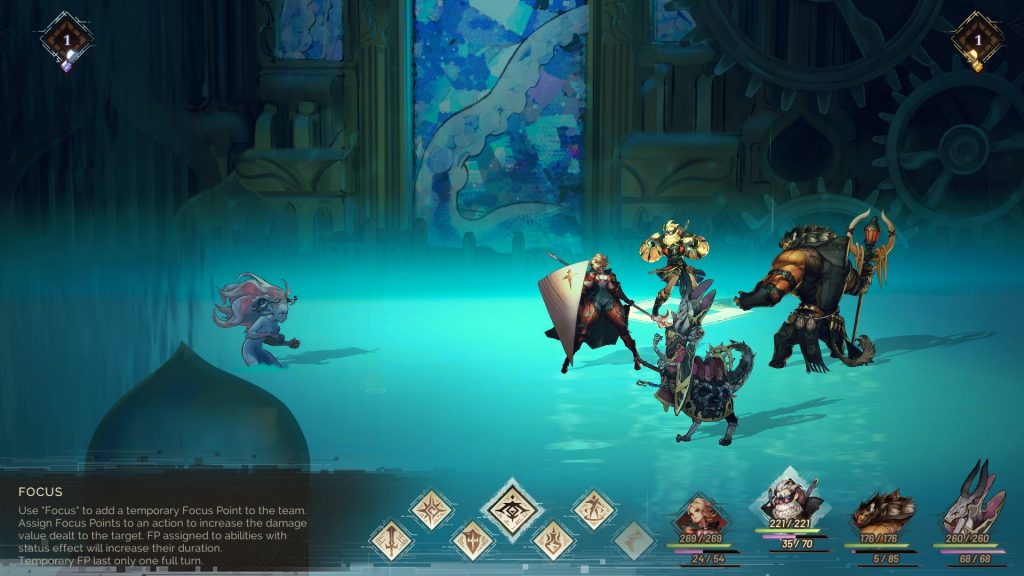
As of the writing of this review, there isn’t a single option to customize how the game runs on PC, not even a simple resolution or v-sync option. The game also suffers from what I assume are frame pacing problems. That means that even though Steam’s FPS counter never goes down from the game’s intended 60 FPS, it feels as if it’s running at 30 FPS or lower. One can only hope the developers will be able to patch out these shortcomings in time for the game’s release.
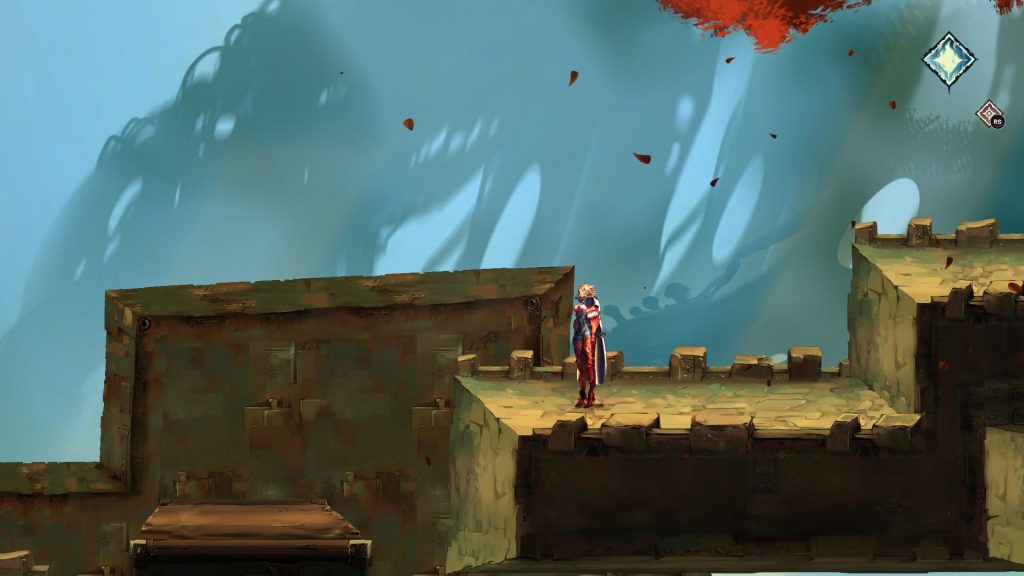
Audio
Hitoshi Sakimoto has a very distinct style of composition that he uses in every game he works on. Those who played Final Fantasy XII, and especially Vagrant Story, know the range, variety and quality that he’s capable of when making music. Astria Ascending is definitely not his best work, but it certainly has his DNA. The music and sound effects only add to Astria Ascending’s overall quality.
Overall
Unfortunately, Astria Ascending is unable to deliver the high quality, traditional JRPG experience it’s hyped up to be. It misses the mark by a long shot, especially in regards to its story. It can still be a fun experience if you dial down your expectations. The art style, even with its inconsistencies, is charming enough, and the soundtrack will please any J-RPG aficionado, especially fans of Sakimoto-san and his past works.
Capsule Computers review guidelines can be found here.


